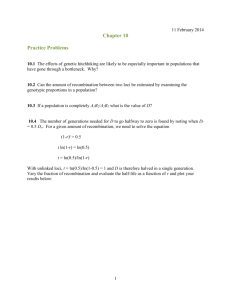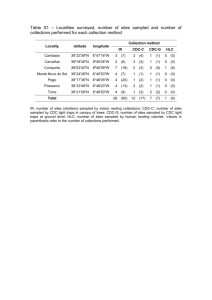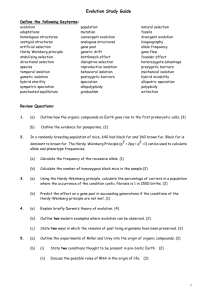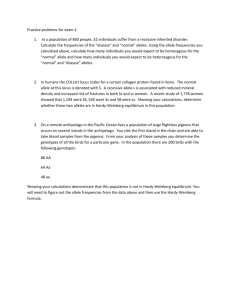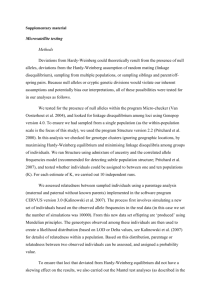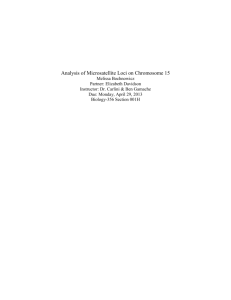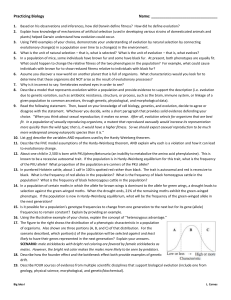Chapter 5 Practice Problems
advertisement
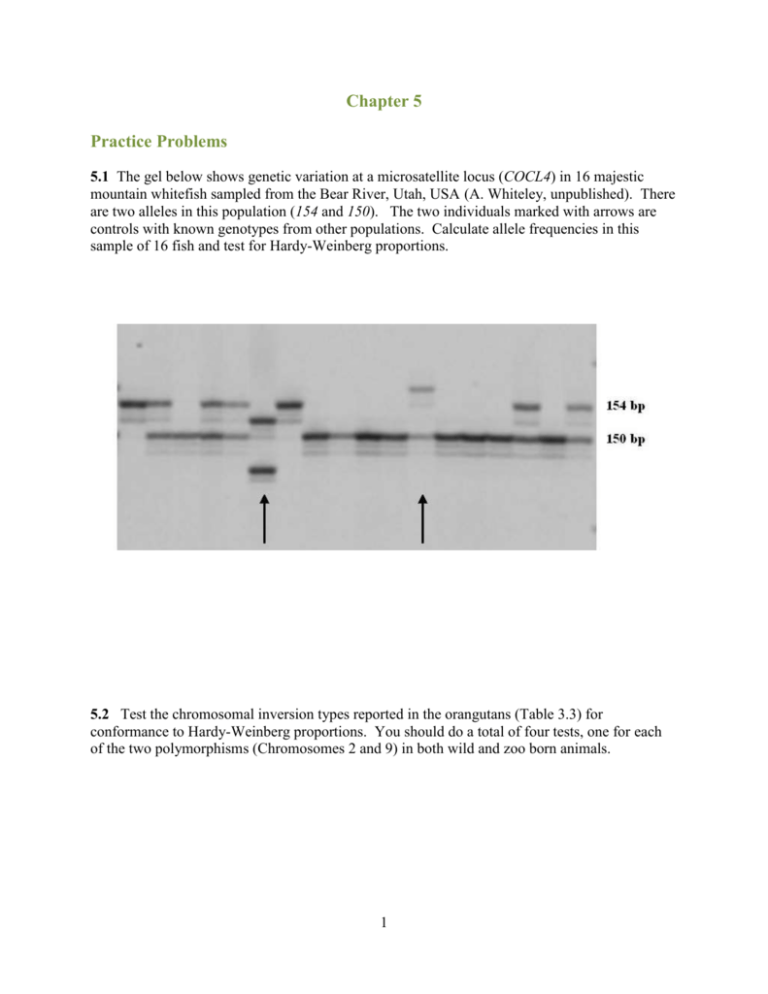
Chapter 5 Practice Problems 5.1 The gel below shows genetic variation at a microsatellite locus (COCL4) in 16 majestic mountain whitefish sampled from the Bear River, Utah, USA (A. Whiteley, unpublished). There are two alleles in this population (154 and 150). The two individuals marked with arrows are controls with known genotypes from other populations. Calculate allele frequencies in this sample of 16 fish and test for Hardy-Weinberg proportions. 5.2 Test the chromosomal inversion types reported in the orangutans (Table 3.3) for conformance to Hardy-Weinberg proportions. You should do a total of four tests, one for each of the two polymorphisms (Chromosomes 2 and 9) in both wild and zoo born animals. 1 5.3 The following genotypic data were collected at 34 allozyme loci from brown bears on the mainland of Alaska and Canada (see Table 4.1). Complete the table. Is there any indication that these genotypes differ from expected Hardy-Weinberg proportions? The most common allele at each locus is designated as 1. Genotypes Allele frequencies Locus 11 12 22 13 23 33 GPI-2 81 2 0 -- -- -- LDH-A 77 6 0 -- -- -- PGD 39 30 7 1 3 3 PGM-1 55 26 2 -- -- -- TPI-1 67 16 0 -- -- -- 29 loci 83 -- -- -- -- -- 1 2 X2 3 df Prob 0.988 0.012 0.000 Calculate the mean expected heterozygosity (He), and the proportion of loci that are polymorphic (P) for this population sample at these 34 loci. 5.4 O'Donald and his colleagues have studied the genetics and evolution of color phases of the Arctic skua (Stercorarius parasiticus) for many years on Fair Isle, Scotland (O'Donald and Davis 1959, 1975). Some birds have pale plumage with a white neck and body while other birds have a dark brown head and body. The breeding adults and their chicks (normally two per brood) are caught and classified just before flying. The following results were obtained through 1951-1958: Chicks Parental types Pale Dark Pale x Pale 29 0 Pale x Dark 52 86 Dark x Dark 25 240 Total 106 326 2 Describe a single locus model that fits the above inheritance results. Assume that the chicks represent a random sample of the population and use your genetic model to estimate allele frequencies. What proportion of chicks resulting from matings between dark parents are expected to be pale if your genetic model is correct and the population is in Hardy-Weinberg proportions? Does this agree with the observations? (See Example 5.4). 5.5 Groombridge et al. (2000) have described the loss of genetic variation in kestrels (Falco punctatus) on the Indian Ocean Island of Mauritius by comparing genotypes at 10 microsatellite loci in 26 individuals from museum specimens up to 150 years old and 75 individuals from the extant Mauritius population. Only three of these 10 loci are polymorphic in the extant population (5, 82-2, and Fu-2). We will examine these data in more detail in the next chapter. There is an Excel file (Mauritius kestrel data) on this webpage that presents the original data from these authors. (a) Test if the genotype frequencies from the extant population are in Hardy-Weinberg proportions using the genotypic data presented in Sheet 1. (Note: Do not test the historical sample for Hardy-Weinberg proportions because the sample size is so small and there are so many alleles at some loci.) (b) Use the allele frequencies presented in Sheet 2 to calculate the average expected heterozygosity (He) of the historical and current population of Mauritius kestrels at these 10 loci. 5.6 Seven of 50 black bears sampled on Princess Royal Island off the coast of British Columbia were white (Marshall and Ritland 2002). As discussed in Chapter 2, white bears are homozygous for a recessive allele at the MC1R locus (aa). (a) Estimate the frequency of the a allele in black bears on this island. (b) What is the probability that the first cub produced by a mating between a white (aa) and a black bear (AA or Aa) in this population will be white? 5.7 The Gouldian finch of northern Australia is polymorphic for facial color. Most birds are black-faced, but some birds are red-faced. Inheritance results have indicated that black-faced is caused by a recessive allele (r) that is Z-linked (Buckley 1987). The following phenotypes were observed in birds from the Yinberrie Hills (Franklin and Dostine 2000): 3 Males Females Total Black 97 93 190 Red 45 23 68 % red 31.7 19.8 26.4 Are the observed frequencies compatible with the proposed model of black-faced being caused by a Z-linked recessive allele? 5.8 We saw in Section 5.3 and Guest Box 5 that an examination of the pattern across samples and loci can be important for identifying possible causes for observed deviations from HardyWeinberg proportions. Let’s again consider a situation where eight deviations (P<0.05) from Hardy-Weinberg proportions are detected in a study of ten loci examined in ten population samples. Assume that all eight of these deviations are found in the sample population and there is an excess of heterozygotes in all cases. Suggest a possible explanation for this observation. 4 Assignment Problems 5.9 What is the probability that the grandson of the senior author of this book is color-blind? His mother has normal vision, and she is the daughter of the senior author. The senior author is red-green color-blind. 5.10 Let’s again consider the situation in Section 5.3.2 in which 10 loci in 10 population samples are tested for Hardy-Weinberg proportions, and eight out of the 100 tests show significant deviations (P<0.05) from Hardy-Weinberg proportions. All eight of these deviations are found at the same locus, and all show an excess of heterozygotes. Suggest a possible explanation for this observation. 5.11 Approximately 1% of the magpies (Pica pica) on in a hypothetical populations are albino. Assume that the albino phenotype is due to a recessive allele and that this population is in Hardy-Weinberg proportions at this locus. (a) What is the estimated frequency of the albino allele in this population? (b) What is the probability that the first progeny born to a mating between an albino and a normal magpie from this population will be albino? 5.12 Small populations are often said to be "inbred". This has been called "the inbreeding effect of small populations. FIS is a measure of “the current amount of inbreeding within a population" FIS = 1 - (HO/HS) where HS is the expected frequency of heterozygotes in a population assuming Hardy-Weinberg proportions, and HO is the observed frequency of heterozygotes. Positive values of FIS indicate an excess of homozygotes and inbreeding. Therefore, the greater the value of FIS, the greater the amount of inbreeding within a population. (a) We have seen, however, that FIS will tend to be negative in small populations. Why? (b) Negative FIS values in small populations would indicate that small populations tend to be less inbred than large populations. Explain this contradiction. 5
